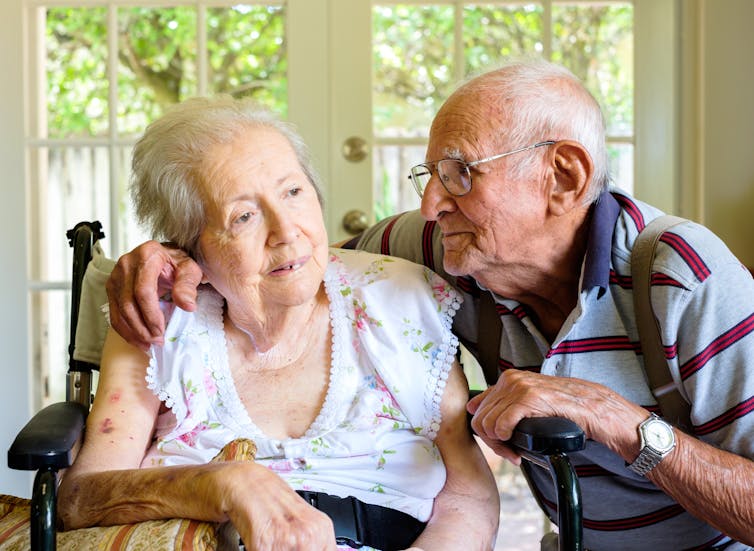You Can Sit Around and Wait a Hundred Years but You Aint Gonna Hear Anything Like This Again
This is ane of two final articles in our Coping with Bloodshed series. Today's accompanying slice explains the importance of effectively using palliative intendance services. You can read previous articles in our series here.
Across the adult world more people are living longer, which of grade means more get to be extremely onetime by the time they dice. Nearly one-half of all deaths in the Britain are in people aged 85 or older, upwards from only one in v just 25 years ago.
Dying in older age tin can mean a different sort of death, such equally becoming gradually frailer in both body and heed and developing numerous health problems over many years. Where years after retirement were previously considered simply old age, a longer life span means the afterward years at present include variation reflected in labels such as younger former and older old.
Our previous research showed people who are over 90 when they die need more support with daily life in their terminal twelvemonth than even those who die in their belatedly 80s. In the United kingdom of great britain and northern ireland, effectually 85% of those dying anile 90 or older were so disabled as to need assistance in basic self care activities. Only 59% of those between 85 and 89 at death had this level of disability.
This noesis has implications for planning support for life and death in dissimilar care settings. But what practise we know most what the older old (95 plus) people actually want when it comes to decisions well-nigh their care every bit they approach the end of their lives?

How the older old feel about dying
The oldest and frailest in our society are becoming less visible as many who demand the most support, such equally those with dementia, are either in care homes or less able to get out and well-nigh. Merely their voices are crucial to shaping end-of-life care services.
In our latest inquiry, we had conversations about care experiences and preferences with 33 women and men aged at least 95, some over 100, and 39 of their relatives or carers. Of these, 88% were women, 86% were widowed and 42% lived in care homes.
Decease was part of life for many of the older people who frequently said they were taking each day as it comes and non worrying too much about tomorrow. "It is merely day-from-twenty-four hours when you lot get to 97," said one adult female. Most felt set to die and some even welcomed it: "I just say I'm the lady-in-waiting, waiting to go," said one.
Others were more drastic in their want to reach the end. "I wish I could snuff it. I'g but in the way," was a typical sentiment in those who felt they were a nuisance. Others begged not to exist left to live until they were a hundred, saying at that place was no point to keeping them alive.
Most were concerned about the impact on those left behind: "The only thing I'grand worried about is my sister. I hope that she'll be not distressing and be able to come to terms with it."
The dying process itself was the cause of virtually worries. A peaceful and painless death, preferably during sleep, was a mutual ideal. Interviewees mainly preferred to be made comfy rather than take treatment, wishing to avoid going into hospital.
Nosotros institute families' understanding of their relative's preferences only occasionally incorrect (just twice). For example, one person said they wanted to have treatment for as long equally they could, while their family unit member believed they would prefer palliative care. This highlights the importance of trying to talk options through with the older person rather than bold their family knows their views.
We found almost discussed end-of-life preferences willingly and many mentioned previous talk nearly decease was uncommon, often simply alluded to or couched in sense of humor. A minority weren't interested in these discussions.

We demand to talk with the older quondam
It's rare to hear from people in their tenth or eleventh decade only there are some studies that have explored the views of the younger quondam. Most often these have concentrated on intendance home residents and occasionally on those living at dwelling.
A literature review conducted in Sweden in 2013 found a full of 33 studies across the world that explored views of death and dying amid older people, although very few of these sought the views of the older onetime.
A 2002 report found older people in Ghana looked forrard to expiry, seeing it as a welcome visitor that would bring peace and rest after a strenuous life. And a 2013 study in the Netherlands showed many people changed their preferences on how they wanted to dice as their intendance needs inverse.
A recent review examined older people'south attitudes towards advance care plans and preferences for when to start such discussions. Information technology identified 24 studies, mainly from the Usa and with younger old historic period ranges. The results showed that while a minority shirked from end-of-life care give-and-take, most would welcome them but were rarely given the opportunity.
These studies support our findings on older people's willingness to talk over oftentimes taboo topics, their acceptance of impending decease, and their concerns around what the dying process would bring: increasing dependence, being a burden and the impact of their own death on those left backside.
To plan services to best support rising numbers of people dying at increasingly older ages in different settings, we need to understand their priorities equally they nearly the end of life.
Source: https://theconversation.com/heres-what-people-in-their-90s-really-think-about-death-58053
0 Response to "You Can Sit Around and Wait a Hundred Years but You Aint Gonna Hear Anything Like This Again"
Post a Comment